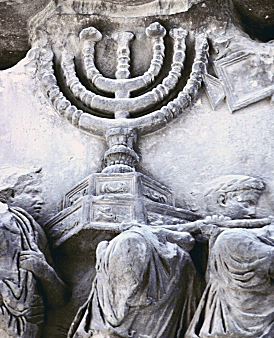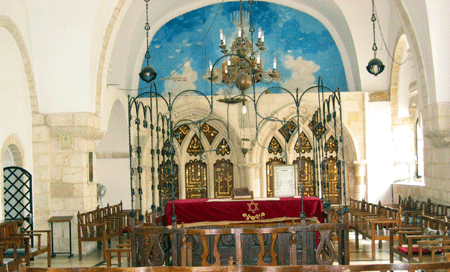|
|
|
 |
|
“ELI
WAS SITTING ON A SEAT, WAITING BESIDE THE ROAD --
HIS HEART TREMBLING FOR THE ARK OF GOD”
I SAMUEL 4:13
|
|

|
 |
“If you have a sapling in your hand and someone runs
in to announce ‘the messiah has come’,” said first
century A.D. Rabbi Yochanon, “plant the sapling
first and then greet the messiah.” Rabbi
Yochanon ben Zakkai was a prudent man.
In his youth Ben Zakkai had been a pupil of the
great sage Hillel, one of the most renowned sages in
Jerusalem. He had served as co-president of
the Sanhedrin and his discourses in the Temple
courtyard drew large crowds. Although his
nephew, Ben Batiah, was one of the leaders of the
radical Zealots resisting the Romans, Rabbi Yochanon
counseled moderation.
During the three and a half years that the Roman
General Vespasian besieged Jerusalem, city residents
were polarized between those who supported the
rebellion against Rome and those who were opposed.
Despite the siege, four wealthy city councilmen kept
the storehouses filled with wheat and barley.
Then Ben Zakkai’s nephew, who was in charge of the
stores, burned them to ash, to encourage his fellow
citizens to go out to fight the Romans.
|
|
 |
|
Photo: Gila
Yudkin |
|
Model of 1st century AD Jerusalem;
the Temple is on the upper right |
| |
As Rabbi Yochanon walked through the marketplace, he
witnessed Jerusalemites boiling straw and then
drinking it as if it were soup. He asked
himself, “Can men who boil straw and drink its water
resist the armies of Vespasian?” He appealed
to the Zealots leading the revolt to desist.
But they replied that they had killed Vespasian’s
predecessors and he would meet the same fate.
Realizing that Jerusalem was doomed, Rabbi Yochanon
decided to escape the besieged city in order to
rescue Judaism.
|
 |
According
to a Talmudic legend, he escaped by having his most
gifted disciples carry him outside the city walls in
a coffin. (Only corpses were allowed to leave the
city.) When they reached the Zealot outpost,
the Zealot guard wanted to stick a sword through the
coffin to be sure the “corpse” was dead. Ben
Zakkai’s pupils protested, “Thus you would defile
the body of our leader?” The Zealot guard who
respected the dead, let the coffin leave the city.
His disciples brought him to the cemetery where Ben
Zakkai climbed out of the coffin and walked to
Vespasian’s camp. He asked to see the general.
He was taken before Vespasian and greeted him,
“Shalom to you, O king, Shalom to you O king.”
Vespasian replied, “You deserve to be executed
twice, once because I am no |
|
The Menorah which once stood in
the Temple courtyard is depicted as booty |
king and
secondly, if the real king heard about this, he
would put me to death.” |
Vespasian ordered Rabbi Yochanon to be put in
solitary confinement.
Three days later, Vespasian went to the hot baths
at Gofna, outside Jerusalem. After he had
bathed and had put on one of his boots, a courier
arrived from Rome and proclaimed, “Rise, Nero is
dead and the nobles of Rome have chosen you king.”
Legend describes Vespasian with one boot on, and
unable to put on the other boot, for his feet had
swelled. Poor guy – then he couldn’t get the
other boot off! One of his aides suggested that the
esteemed rabbi prisoner might have a solution.
And indeed he did.
Rabbi Yochanon told him, that according to Proverbs
15:30, his feet swelled because good news makes the
bones fat. He should have the person he hated
the most be brought in front of him, advised the
rabbi. Sure enough, his foot shrank, for
according to Proverbs 17:22, “Despondency dries up
the bones,” and he was able to put on the other
boot.
Relieved and grateful, Vespasian asked the rabbi how
he could reward him. “I beg you, abandon this
city of Jerusalem and depart,” replied Rabbi
Yochanon without hesitation. Vespasian
responded that this was impossible. “Did the
Romans proclaim me king that I should abandon this
city? Make another request and I will grant
it.” Ben Zakkai obtained a promise that the five
leading rabbis would have their lives spared and be
allowed to establish a teaching academy in Yavne, a
village south of Jaffa on the Mediterranean coast.
|
| |
At the
moment Jerusalem was captured, Rabbi
Yochanon was awaiting the news. When he
heard that Jerusalem was destroyed and the
Temple in flames, he rent his clothes, cried
out and wept. He was compared to Eli
waiting for the news of the capture of the
Ark of the Covenant. (I Samuel 4:13)
While a minority of Jews continued to resist
the Romans from their fortress at Masada,
Rabbi Yochanon revived the Sanhedrin with
Yavne as its new seat. On the first
Rosh HaShana, the Jewish New Year, after the
destruction of the Temple, the question
arose as to whether to sound the shofar
(ram’s horn) in Yavne. Until then it
had been permitted only in the Temple.
Some of the sages suggested, let us debate
the issue. Rabbi Yochanon declared, “There
is no time for debate; it is a time to act.”
The shofar was sounded. To this day,
the shofar, once blown only in the Temple,
is sounded in Jewish synagogues throughout
the world to announce the New Year.
Rabbi Yochanon did succeed in rescuing and
reinvigorating Judaism. Prayers facing
Jerusalem were instituted in place of the
daily sacrifice in the Temple. Rabbi
Yochanon, a native of Jerusalem, was not a
pilgrim himself, but he introduced the call
to pilgrimage when his academy added the
pledge, "Next Year in Jerusalem" to the
Passover Seder. And thus, the hope of
a rebuilt third Temple was kindled.
On your free day in Jerusalem, while roaming
the Jewish Quarter, you may want to visit
the Ben Zakkai Synagogue, not too far from
the Zion Gate. According to tradition,
the synagogue sits on the site where Rabbi
Yochanon Ben Zakkai used to teach his
pupils. |
| |
|
Copyright 2006
Gila Yudkin. Permission needed for any reuse. |
| |
|
 |
|
Photo:
Gila Yudkin |
|
According to tradition,
the synagogue sits on the site of
Rabbi Yochanon Ben Zakkai’s study house |
| |
| More Holy Land
headliners and celebrities |
|
|
|
|
|
GILA
YUDKIN
•
TCHERNIKOVSKI
64A
•
JERUSALEM
•
ISRAEL
gila@itsgila.com
HOME
•
BOOK
GILA
•
TIPS
FOR TOURS •
ABOUT GILA
|
|

